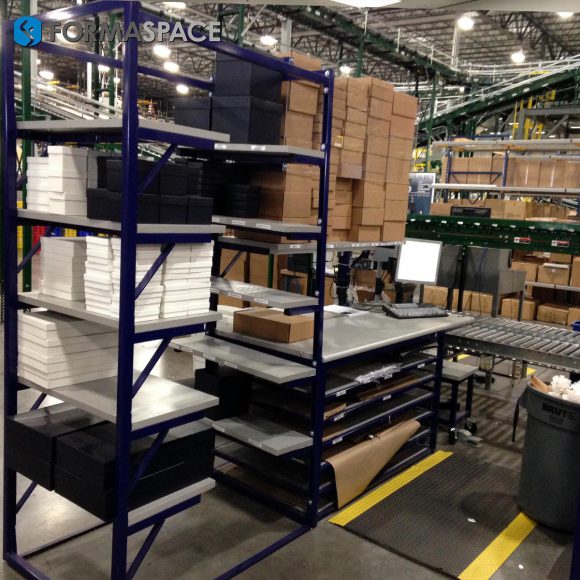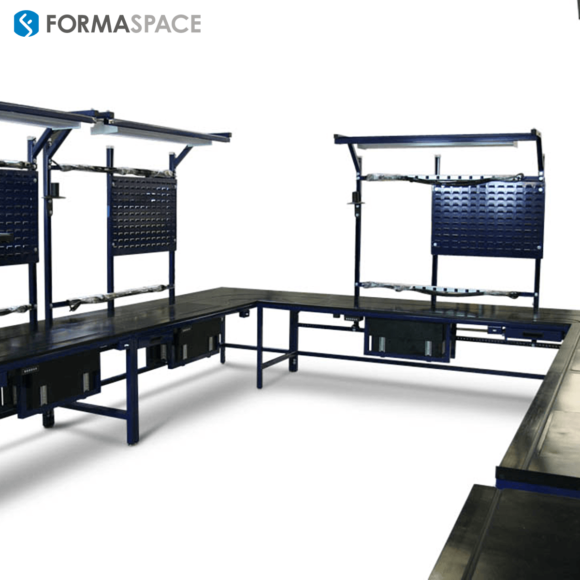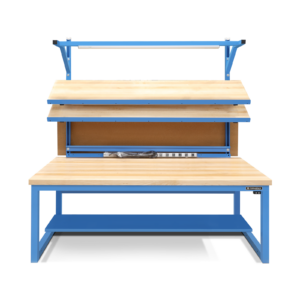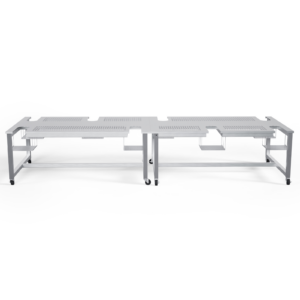President Trump’s recent visit to the Apple computer factory in Austin, Texas, highlights the resurgence of manufacturing in this region. However, manufacturing growth across the country has been uneven in 2019, and the outlook for 2020 is still uncertain. We consider three possible scenarios for US manufacturing in the coming year.
As we approach the 2020 presidential election year, the White House is stepping up its efforts to showcase a resurgence in American manufacturing.
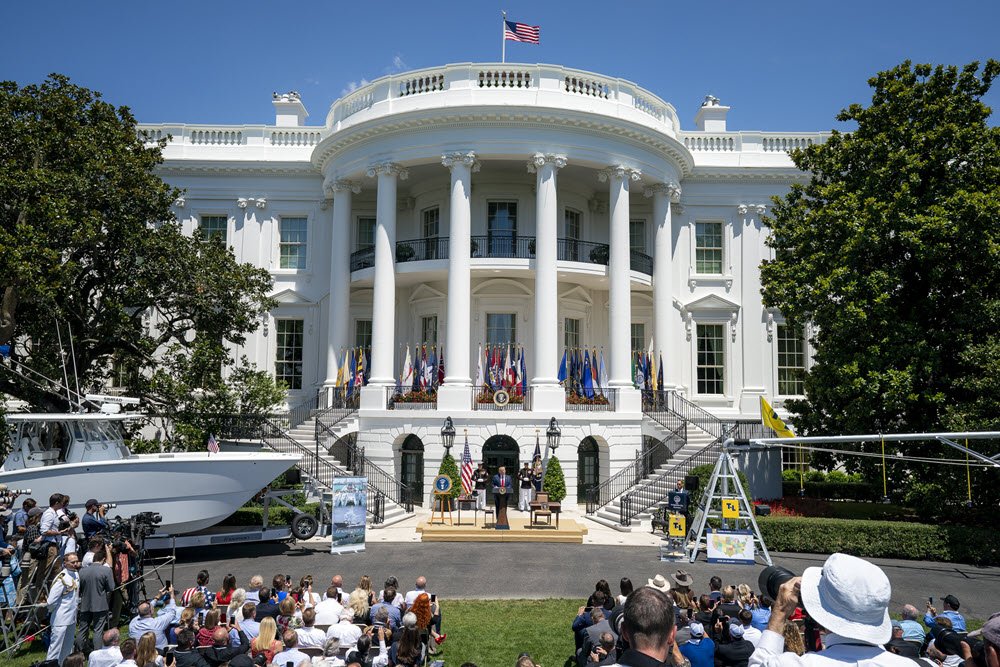
This past July, American manufacturers were invited to the White House to showcase their ‘made-in-American’ products at the third annual 2019 Made in America Product Showcase.
And President Trump has been traveling on the road across the US, touting the administration’s progress in attracting new American manufacturing jobs.

In November, Trump met up with Apple CEO Tim Cook in North Austin (not far from Formaspace’s own factory headquarters) to tour the Flextronics International manufacturing facility, which manufactures the new line ofApple Mac Pro computers.
The White House has reasons to celebrate, but also has reasons for concern.
After years of US manufacturing growth, some warning signs have appeared on the horizon. A strike against GM in October helped push down manufacturing indexes to levels not seen since the Great Recession.
But it’s been an uneven slowdown: manufacturing growth in central Texas remains steady but the upper Midwest is showing greater signs of manufacturing industry weakness.
Unfortunately, one of the key future economic indicators, the PMI (Purchasing Managers Index), has been drifting downward below 50% over the last two quarters, which means we may be skirting with a mild regional recession in manufacturing going into 2020. Manufacturing PMI fell to 47.8% and remained below fifty percent again in November (48.1%).
Manufacturing Outlook for the Year 2020: Three Possible Scenarios
As we enter the highly charged politics of a presidential election year, what can the manufacturing industry expect?
We look at three possible scenarios.
Scenario 1: Kick the Can Down the Road
What if nothing changes significantly over the following twelve months? Unfortunately, that would mean continued uncertainty for American manufacturing.
That’s our prediction for Scenario 1, and to be frank, staying put with the status quo is not terribly good news.
A recent Financial Times opinion piece argues that “trade tensions are strangling American manufacturing.”
Strangling may be too harsh a word, but many manufacturers have experienced cases of repeated whiplash, as the White House has announced (often via early morning tweets) a series of repeated threats against the NAFTA free trade agreement between the US, Canada, and Mexico, as well as a series of tariff threats (and actual tariffs) against Chinese imports, imported steel products, as well as European cars and automotive components.
While the intent (e.g. supporting the growth of the American manufacturing) is laudable, it’s been a tough period for Supply Chain managers forced to rebalance long-standing supply chains in response to new import tariffs. And many manufacturing sales managers have experienced significant heartburn as their sales to China have slowed down, often due to increased retaliatory “inspections” at the border.
Things had been pretty quiet (for a few months at least), but this past week, we’ve seen a renewed threat of on-again, off-again import tariffs. In a stunning volte-face, the White House announced this past week that steel products imported from Brazilian and Argentinian steel would once again face new tariffs (after having been introduced and then abandoned earlier). France was also singled out for $2.4 billion of new tariffs, in a reputedly retaliatory effort directed at their proposed tax on Internet company giants.
Bottom Line for Scenario 1: Continued Uncertainty and the Risk of a Mild Manufacturing Recession
We recently spoke to the CFO of a medium-sized automotive component manufacturer in Michigan that makes aftermarket parts used to rebuild auto and truck engines. Tariffs on imported steel made a direct hit on their bottom line. After many months of waiting, they finally received a tariff exemption (as the steel used in their products is not made in the US), but they are still waiting for a refund on the tariffs they paid before the issuance of the waiver.
The increased cost and prolonged uncertainty (In early December, the President warned that a US-Chinese trade deal might not be resolved before the 2020 elections) is making it difficult for them to make concrete financial plans for 2020, a sentiment shared with other American manufacturing companies, such as a speaker manufacturer based in Minnesota.
As we all know, switching suppliers is expensive and time-consuming. Kicking the can down the road may prolong this uncertainty — as a result, we may experience a mild recession in certain regions/sectors. Meanwhile, the main beneficiary in the short term may be Vietnam as they hoover up factory production lines once based in China.
Scenario 2: New Trade Agreements Reached
In this scenario, things are looking up in early 2020.
Trade tensions cool down, and the trade threats against China, Europe, and other countries are taken off the table in exchange for some meaningful concessions.
In this scenario, Congress ratifies the revised NAFTA agreement, known as USMCA, in the coming months to ensure continued, stable economic relations with the two major economies on our doorstep.
And, despite the rancorous, heated rhetoric, there are some signs that a trade deal with China may happen sooner than later, even if it’s just an interim agreement.
(Because this is the rosy scenario for 2020, we can also hope that any agreement with China makes real, lasting progress in controlling the theft of American intellectual property by Chinese companies.)
Finally, the threat of tariffs against imported steel, European cars and parts, and French wine and cheese, is taken off the table. And a truce is called in the trade sanctions over unfair state-support for Airbus (per the 2019 WTO ruling) as well as Boeing (which the WTO is expected to rule against in 2020).
Bottom Line for Scenario 2: Once-in-a-Generation Opportunity for Renewed Growth
Resolving our ongoing trade disputes in exchange for meaningful concessions would help American manufacturing regain the certainty necessary for increased investment and growth.
Further, if we were able to reach all these agreements, it would offer us a rare, once-in-a-generation opportunity to invest in our manufacturing base. Here are several ways we could make the most of the situation:
- We could invest in the key technologies needed to create a strong manufacturing base.
- We could also invest in training, access to capital, and export assistance for smaller and medium-sized manufacturing companies.
- We could embrace the newest technologies that will help us stay competitive on the world stage, including more investments in robotics, automation, additive manufacturing, AI, and generative manufacturing.
- Finally, we could return to an era of optimism and openness, one that embraces international trade and foreign investment.
Filmmakers Julia Reichert and Steven Bognar discuss their new documentary film, American Factory, which explores the often tense relationships between the US workers at a former GM truck plant in Dayton, Ohio, that’s been renovated by a Chinese billionaire to make glass products.
Scenario 3: The Wheels Come off the Vehicle
In this scenario, things get worse as we enter the year 2020 — our trade disputes escalate into an acrimonious, full-scale currency, trade, and/or protectionism war, the likes of which we haven’t seen since the lead up to the Great Depression of the 1930s.
For an idea of how badly things could turn out in this scenario, we only have to look at past trade history.
In the early 1920s, the Germans, facing economically debilitating reparation payments after losing World War I, resorted to printing vast sums of paper currency to buy the gold and hard currency reserves required under the repayment terms spelled out by the Allies in the Treaty of Versailles.
But printing millions of paper bills ultimately devalued the value of the German currency until its purchasing power collapsed to near zero. (You’ve probably seen old newsreel footage of this German period of hyperinflation in the early 1920s — when a wheelbarrow of bills could barely purchase a loaf of bread.)
The consequences of the German currency manipulation were felt worldwide. German hyperinflation caused its international trade to collapse, and the German government and business began to default on their loans — many of which originated in America — leading to what many economists view as one of the contributing causes of the US Stock Market Crash in late 1929. (It also helped pave the way for the rise of the National Socialists in Germany in 1933.)
Frustrated by the inability of the Germans to repay, the US Congress enacted the (now infamous) Smoot-Hawley Tariff Act of 1930, which has gone down in economics lore as the quintessential poster child for self-defeating trade protectionism. Rather than raise trade revenues, the opposite occurred, as high Smoot-Hawley tariffs on foreign goods were met by increasingly retaliatory tariffs from our trading partners.
This form of ‘beggar thy neighbor’ protectionism backfired in what the Brits call a massive ‘own-goal’:* instead of raising revenue, Smoot-Hawley helped decimate US international trade, helping to bring us further down into the depths of the Great Depression.
*The expression ‘own-goal’ comes from soccer, e.g. when a soccer team somehow manages to kick the ball into their own net, earning a point for the other team.
Bottom Line for Scenario 3: Worldwide Downturn and Retaliatory Trade Measures
Could this doomsday economic scenario happen again in our lifetime?
That was once considered nearly impossible. But in the current circumstances, it’s no longer out of the question.
How could this happen? Here are is a plausible scenario.
- The China – US trade skirmish blows up into full-scale trade war.
- The US imposes billions in tariffs on EU manufactured goods and agricultural products. The EU retaliates.
- China and the EU slow-walk the re-certification of the Boeing 737-MAX, pushing Boeing closer to bankruptcy.
- The US retaliates further with even more tariffs and accusations of currency manipulation, closing off all trade and investment by Americans in Chinese companies or products.
- China stops supplying critical wing parts that Boeing needs to produce its passenger aircraft, pushing Boeing further into crisis. Cut off from its supply chain and biggest growing customer, the US passenger aerospace industry is pushed further into crisis.
- China considers liquidating its substantial position in US Treasury Bills, but on reconsideration, seeks a more strategic position by gathering the support of other countries to establish an alternative reserve currency to stand against the US Dollar.
That’s one way it could happen.
Unfortunately, many of the very financial and trade mechanisms the US helped craft after World War II are under attack — but not from other nations — but from our administration in Washington.
A case in point is GATT (the General Agreement on Tariffs and Trade), which was established after World War II to create trade “rules of the road” to end the type of “wild west” trading practices that helped lead us into the Great Depression. Both GATT (1947 – 1995) and its 1995 successor, the World Trade Organization (WTO), helped build the level playing field for international trade that has been one of the US’ long term economic achievements. In fact, the WTO recently decided a major trade dispute case in favor of Boeing over Airbus.
Yet, despite its successes, the Trump administration has pointedly avoided nominating members to the WTO’s Appellate Body. When two more members reach the end of their terms on Dec. 10, 2019, the WTO won’t have a quorum to hear any future cases. One could ask if this a cynical move by Washington to stitch up the WTO just before it’s expected to make another important trade ruling — this time, in favor of Airbus over Boeing. But with many major free-market trade disputes building up on the horizon, such as the proposed tax on Internet companies by France, the world trading order could break down quickly without the WTO acting as a referee.
And that other critical US financial institutions may also be at risk. It’s one that underpins the world’s economy — yet it’s taken for granted — at least by most Americans. We’re talking about the US Dollar, which usurped British Sterling as the world’s reserve currency after World War II. Much of the world trades in US Dollars, pays its debts in US Dollars, and buys oil in US Dollars— a tremendous, under-appreciated fact that keeps our Federal government’s borrowing costs extremely low and the value of the dollar strong and stable even in times of economic uncertainty.
The adoption of a new world reserve currency to replace the US dollar would be a serious blow to the long-term success of the US economy. Yet, this may come to pass sooner than we’d like, as a form of payback from our trading partners around the world.
Finally, why would we even bring up these dire predictions? We do so in the hope that they don’t come to pass, at least, not in our lifetimes. Yet we need to be vigilant to avoid the economic mistakes of the past.
Formaspace is Your Manufacturing Partner
We service the leading manufacturing companies in the world, including many famous Fortune 500 and Fortune 50 names by providing complete custom industrial furniture solutions, made right here in the USA.
But we’re also here to help smaller manufacturing companies and startups who are seeking ways to make their operations more efficient and profitable.
Take the time to introduce yourself to your Formaspace Design Consultant. They can show you how Formaspace can work with you to design custom furniture solutions – built in our Austin, Texas factory headquarters – that can improve the efficiency, safety, and ergonomics of your factory assembly lines, material handling operations, testing laboratories, or distributions centers and logistics operations.
Make the call today. You’ll be glad you did.


